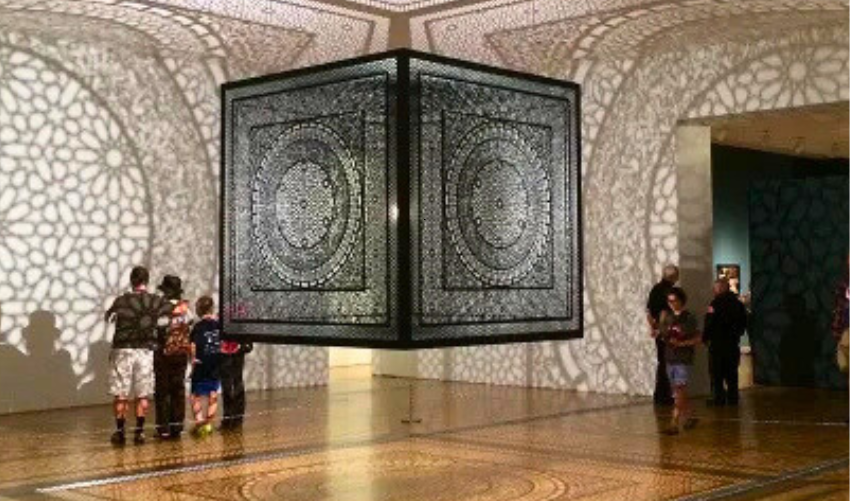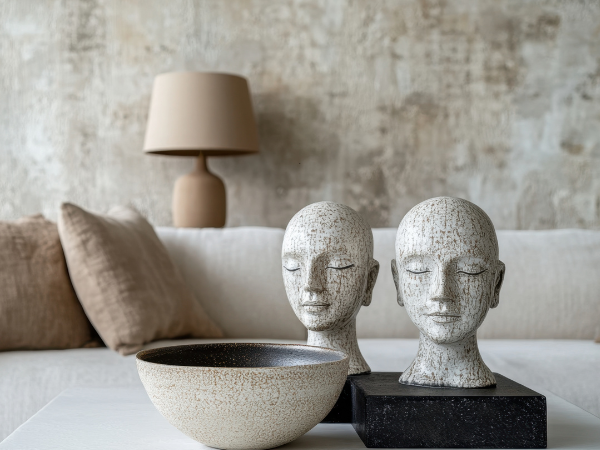“Intersections” by Anila Quayyum Agha is more than just an art installation—it’s an experience that invites you to explore culture, identity, and connection in a whole new way.
This powerful piece draws you in, making you see familiar patterns through a fresh lens. If you want to discover how art can transform a space and your perspective, keep reading.
Artist Background
Intersectionsby Anila Quayyum Agha is a captivating artwork that blends light, shadow, and culture. This piece reflects deep themes about identity, connection, and boundaries. Understanding the artist’s background reveals the rich context behind her work.
Early Life And Education
Anila Quayyum Agha was born in Lahore, Pakistan. Her early years were surrounded by traditional Islamic art and architecture. This environment inspired her love for patterns and intricate designs.
Her formal education played a key role in developing her skills and style. She studied fine arts with focus on painting and printmaking. Later, she pursued advanced studies in the United States.
- Received Bachelor of Fine Arts in Pakistan
- Moved to the U.S. for graduate studies
- Earned a Master of Fine Arts degree
- Focused on printmaking and installation art
Her education combined traditional techniques with modern art concepts. This blend allowed her to create work that speaks across cultures. Anila also worked as a teacher, sharing her knowledge with new artists. Her background is a mix of cultural heritage and academic training.
Artistic Influences
Anila’s work draws from many sources. Her roots in Islamic art deeply influence her use of geometric patterns and light. She often explores themes of cultural identity and social issues. Her art reflects a desire to connect different worlds.
Key influences in her work include:
- Islamic Art: The intricate patterns and calligraphy inspire her designs.
- Contemporary Artists: She admires artists who use light and shadow creatively.
- Personal Experiences: Her migration and cultural shifts shape her themes.
Her installations often use light to create shadows that tell stories. This technique invites viewers to explore hidden meanings. The interplay of light and dark symbolizes unity and division.
Artwork Description
This piece invites viewers into a space where light and shadow interact, creating a powerful visual experience. The artwork’s intricate design and thoughtful execution reflect the artist’s deep engagement with traditional patterns and contemporary issues.
Materials And Techniques
The artwork uses a mix of traditional and modern materials to create its unique effect. Anila Quayyum Agha primarily works with laser-cut wood. The wood is carefully carved with intricate geometric patterns inspired by Islamic architecture.
- Laser-cut wood: Allows precise and detailed patterns.
- Light source: A strong light inside the piece casts shadows on surrounding walls.
- Installation setup: The artwork is suspended in a room to maximize shadow play.
The process involves designing the pattern digitally, then cutting it on wood using laser technology. This method ensures accuracy and clean edges, which is crucial for the detailed shapes. The light inside the piece shines through the cutouts, projecting complex shadows.
| Material | Purpose | Effect |
|---|---|---|
| Wood | Base structure | Durable, holds patterns well |
| Laser cutter | Precision cutting | Clean, sharp patterns |
| Light source | Shadow projection | Creates large-scale shadow patterns |
This technique creates a blend of physical artwork and light art. The shadows extend the piece beyond its physical form, making the whole room part of the experience. This combination reflects the artist’s skill in merging craft with technology.
Visual Elements
The visual impact of Intersectionsis rooted in the contrast between light and darkness. The artwork’s main visual feature is its complex geometric patterns. These patterns are inspired by Islamic art, known for its symmetry and repetition.
Viewers see a cube-like structure covered in detailed cutouts. When lit from inside, the patterns cast large shadows. These shadows create an immersive environment, surrounding the viewer with light and dark shapes.
- Geometry: Repetitive shapes create rhythm and harmony.
- Light and shadow: Interaction produces depth and movement.
- Scale: Shadows expand the artwork’s size dramatically.
- Color: Mostly natural wood tones with warm light.
The patterns include stars, hexagons, and other polygons. These shapes overlap, creating a sense of layers and complexity. The shadows change as the viewer moves, making the experience dynamic.
| Visual Element | Description | Effect |
|---|---|---|
| Geometric patterns | Intricate, symmetrical shapes | Creates visual balance and interest |
| Shadow play | Projected patterns on walls | Transforms space, adds drama |
| Light source | Warm and focused | Enhances texture and contrast |
This use of light and pattern invites reflection on cultural intersections and shared human experiences. The visual elements combine to make Intersections both a physical object and an emotional journey.
Symbolism And Themes
Intersections by Anila Quayyum Agha is a powerful artwork filled with deep symbolism and rich themes. It invites viewers to explore ideas about culture, identity, and human connection. The piece uses light and shadow to create a space where different meanings meet and interact.
Cultural References
Anila Quayyum Agha draws heavily on her cultural heritage to shape Intersections. The artwork features patterns inspired by Islamic art and architecture. These intricate designs symbolize the beauty and complexity of cultural traditions. The use of geometric shapes reflects centuries-old crafts that connect past to present.
The cultural references include:
- Islamic lattice work: Represents privacy, protection, and spirituality.
- South Asian design motifs: Show the artist’s roots and family history.
- Global influences: Suggest the blending of cultures in today’s world.
This mix of cultural symbols creates a dialogue about identity and belonging. It highlights how traditions shape personal and collective stories. The artwork becomes a meeting point for different cultures, showing respect and curiosity.
Light And Shadow
The use of light and shadow is central to Intersections. Agha’s installation casts shadows of its patterns onto the walls, creating a dramatic visual effect. These shadows symbolize unseen forces and hidden stories. Light passes through the design, illuminating parts while leaving others in darkness.
Key aspects of light and shadow include:
- Contrast: Shows the tension between visibility and invisibility.
- Movement: Shadows shift with the light, symbolizing change and fluidity.
- Connection: Light links the physical object to its environment, creating a shared space.
The interplay of light and shadow invites viewers to reflect on what is revealed or concealed in society. It suggests that understanding comes from looking beyond surface appearances. The artwork uses this dynamic to explore themes of openness and mystery.
Identity And Space
Intersections explores how identity is shaped by space and environment. The installation creates an immersive room where viewers stand inside the projected patterns. This physical experience connects personal identity with the surrounding space.
The themes related to identity and space include:
| Theme | Description |
|---|---|
| Belonging | Feeling part of a larger cultural or social group. |
| Isolation | The experience of being separate or different from others. |
| Intersectionality | How multiple identities overlap and influence each other. |
The space within the artwork becomes a metaphor for personal and communal identity. It asks viewers to consider how their own identity fits within different cultural and social frameworks.
Exhibition History
The exhibition history of Intersections highlights its journey across galleries and museums worldwide. Tracking this history reveals the artwork’s growing influence and the diverse audiences it has touched. Each exhibition offers a new context, enriching the meaning and impact of the piece.
Major Showcases
Intersections first gained wide attention at the 2014 Venice Biennale, a prestigious international art event. Its unique blend of traditional Islamic art and contemporary design captivated visitors. After Venice, the artwork traveled to several prominent venues:
- Everson Museum of Art, Syracuse – where it was displayed as part of a modern art collection.
- Albright-Knox Art Gallery, Buffalo – showcased during a special exhibition on cultural identity.
- National Museum of Women in the Arts, Washington D.C. – highlighting women artists globally.
- Various international galleries – including exhibitions in Canada, Europe, and Asia.
The artwork’s travel schedule often coincided with cultural festivals and art fairs. This helped attract diverse visitors, increasing its global reach.
Public Reception
The public response to Intersections has been overwhelmingly positive. Visitors often describe the piece as mesmerizingand thought-provoking. The play of light and shadow invites viewers to reflect on themes of culture, identity, and unity.
Common reactions include:
- Awe at the intricate patterns and craftsmanship
- Curiosity about cultural symbolism
- Emotional connection to themes of inclusion and belonging
Feedback collected from exhibitions shows that many people felt the installation created a peaceful and contemplative space. Educators have also used Intersections to teach about cultural diversity and artistic expression.
| Reaction Type | Percentage of Visitors |
|---|---|
| Felt emotionally moved | 65% |
| Interested in cultural themes | 70% |
| Found the artwork visually stunning | 85% |
Overall, the public reception confirms Intersections as a meaningful work that connects deeply with diverse audiences. It sparks conversations and leaves a lasting impression.
Impact And Legacy
The impact and legacyof this piece reach far beyond its physical form. It has sparked conversations about art’s role in society and inspired many artists and viewers worldwide.
Influence On Contemporary Art
Intersectionshas made a notable mark on contemporary art through its unique use of traditional motifs and modern technology. The work combines handcrafted wooden screens with light and shadow to create immersive experiences. This approach has influenced many artists to explore similar themes and methods.
Key ways Intersectionsshaped contemporary art include:
- Revival of traditional craft: Artists incorporate cultural patterns and techniques.
- Use of light and shadow: Plays with perception and space in installations.
- Interactive art: Encourages viewer engagement and emotional response.
- Cross-cultural dialogue: Bridges art from different regions and traditions.
The piece encourages a blend of old and new, making art more accessible and relevant. Many exhibitions now feature installations inspired by Agha’s method.
Social And Political Context
Intersectionsaddresses important social and political issues through its visual language. The artwork reflects on division, connection, and the search for common ground. It highlights how art can speak about complex topics in a simple, powerful way.
The work’s impact includes:
- Highlighting cultural identity: Encourages pride and understanding of diverse heritages.
- Challenging social barriers: Symbolizes breaking down walls between communities.
- Promoting peace: Visualizes harmony through shared patterns and light.
- Encouraging dialogue: Opens conversations about immigration, religion, and coexistence.
The piece uses Islamic geometric patterns, known for their spiritual meaning. This choice invites viewers to reflect on unity beyond religion or politics. It shows how art can create safe spaces for discussion.
In many exhibitions, Intersectionshas been a focal point for talks and educational programs. It challenges audiences to think about global issues in personal ways.




